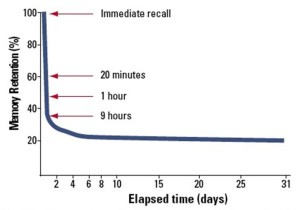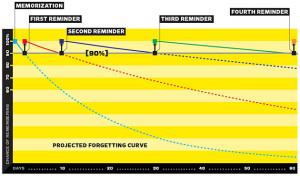Key Concepts: Linear Study; Forgetting Curve; Review Efficiency Effect; Spacing Effect; Spaced Repetition
Summary: We were taught to study chapter by chapter, then cram for exams. We continue to use this approach through adulthood. But the Curve of Forgetting demonstrates that we will soon forget most information learned this way. The best approach is review as you progress: spaced repetition.
We Were Doomed To Forget
We’ve all been there. It might have been for a class, a presentation, a training course, a promotion exam, or even a recital. You might be diligently keeping up with the current research in your field. And you committed to study, knowing how crucial increasing your knowledge base is inside this increasing information boom.
You attended [nearly] all of the [important] lectures, conferences, or seminars. You’ve read [virtually] all of the relevant books and articles. Your notes were [almost] perfect. And at the moment of truth, you succeeded.
A Month Or Two Passes…
And you have to spend days re-studying previous materials for a cumulative exam. A client calls for a simple fact and you’re floundering for Wikipedia. Your boss simply asks you to repeat that hit presentation next Monday and you have to give up the weekend.
All of those precious weeks and months of preparation: gone.
What Happened?
The culprit is our schooling. We were doomed from the beginning. Most of us (except for the lucky few who grew up among psychologists) learned to study linearly. We were taught a chapter or two, then were tested, then moved on to the next, over and over again. This carries on into adulthood, for anything that require studying and memorizing information.
This works if the whole point of studying endlessly was to pass an exam and forget everything about it. But this is rarely the case. The whole point of all that work was to remember. You need this hard-won knowledge for your next class, your clients, or for yourself.
I’m here to show you a different approach.
The Problem: The Forgetting Curve
It all starts with Herman Ebbinghaus, considered the father of modern memory psychology. He memorized series of syllables and charted his recall through a period of days and weeks. What he found was simple, but revolutionary: his memory deteriorated surprisingly rapidly. The chart is called the forgetting curve. It has proven true time and time again.
And we forget far more quickly than we realize: Exponentially. Even after a few days, we’ve likely forgotten a large percentage of what we studied. In a week, the vast majority is lost. This is why exactly people we get so frantic when it comes time to cram: we have to learn the material all over again. It almost seems impossible to escape from. It also explains Are You Smarter Than A 5th Grader!
But There Is Hope: The Review Efficiency Effect
Relearning the material likely did not take as long as learning it initially. If it didn’t, a full week of studying would not be enough for months of learning. And we passed the exam.
Then promptly forgot the material all over again.
Yet this is the beginning of the end of our old enemy, the forgetting curve. If relearning is quicker than learning, then reviewing another time will be even quicker. Here we have discovered a crucial piece of intelligence: Reviewing information becomes more efficient the more we engage in it. There are many academic terms and explanations that describe how and why this occurs—which I will cover later—and these are beyond the scope of this article. So forgive me as I dub this (unofficially) as the review efficiency effect.
Enter: The Spacing Effect
The spacing effect in a nutshell: we remember better if things we study repeatedly over a period of time, rather than in one massed clump. And effect of spacing on the forgetting curve is remarkable. Obviously the forgetting curve will begin again when you review. But every time restarts, the forgetting curve becomes shallower. Every time you review a piece of material, it will take longer to forget.
Say Hello to Your New Superpower: Spaced Repetition
Spaced repetition is simply reviewing learned material in a specific schedule. This is your new superpower.
But for maximum efficiency, we must do this before the forgetting curve takes its toll. Remember that the forgetting curve is an exponential beast. You lose most of what you learned within the first week after studying. Think about it this way: The day after you study, the material will be fresh in your head. It will probably take you about 10 minutes to review more than an hour’s worth of material. But after a week, it may take as long as 30 minutes.
This simple habit is so powerful because it combines the power of the spacing effect and our very own review efficiency effect. With spaced repetition, not only will you remember for longer than before, your review will be shorter after. So your first review was 10 minutes? Your next will take around 5. Then 2-3 minutes. By this time, you might not even need your notes. A brief mental review of 1 minute for a lifetime of remembering? Say your final farewells to the forgetting curve.
The Moment Of Truth: How To Use Spaced Repetition
Here are the common guidelines for spaced repetition:
- Learn and study something new to your maximum possible comprehension (~1-3 hours)
- Review the next day (~10 minutes)
- Review 1 week after previous review (~5 minutes)
- Review 1 month after previous review (~2-3 minutes)
- Review as you feel necessary (~1-2 minutes)
These guidelines are not set in stone. The guidelines above describe what is called expanding retrieval practice, a common application of spaced repetition. Psychologists differ in their opinions of the best ways to apply spaced repetition.
Further, every subject of study (academic, business, sports, music, etc.) will impact any individual differently. For example, if a subject is especially difficult, you will want to compress the time scale (e.g. 24 hours, 2 days, 5 days, 1 week, etc.). This is why it is important to experiment with spaced repetition to suit your own needs. It will most likely be the subject of a future post.

